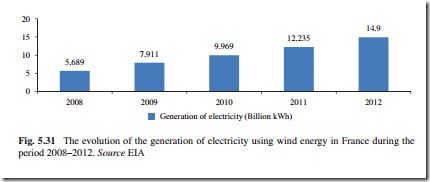France
In 2012, France has wind capacity installed of 7,623 MW, which represents 5.7 % of the total energy capacity installed in the country and 24.15 % of the total renewables capacity installed in that year. France occupies the place number eight at world level according to the wind capacity installed and the place number five at regional level. In the past ten years, the compound annual growth rate was 39.46 % and wind power capacity grew in each one of the ten-year period considered. In 2013, the total wind power capacity installed was 8,254 MW; this represents an increase of 9.2 % with respect to 2012. The major percentage increase in wind power capacity was reached in 2000 (172 %).
France has centered its renewable energy sources approach around FiT on the one hand and a tendering procedure on the other. The French policy for the pro- motion of the use of renewable energy sources for the generation of electricity includes the following mechanisms:
• FiT (introduced in 2001 and 2002, and modified in 2005) for solar PV, hydro, biomass, sewage and landfill gas, municipal solid waste, geothermal, offshore wind, onshore wind, and CHP;
• A tender system for large renewable projects.
France has vast resources of wind, geothermal energy, biomass, wind power and geothermal. In 2014, France approved a goal of reaching 19 GW of wind energy by 2020, up from its current level of 8.2 GW, according to the EWEA latest statistics. This will significantly raise the percentage of wind powered electricity in the country from the 3 % wind covers today. However, and according to a very recent survey published in March 2014, the French are behind this transition.
The French NREAP expects around 11 % of all electricity consumption in 2020 to be met by onshore and offshore wind power. With regard to France’s overall 23 % renewable target for 2020, a total of 27 % of power consumption is planned to be met by renewables (see Table 5.18). After hydro, with a planned 25 GW, of which 6 GW will be offshore, wind power is the main renewable tech- nology in the NREAP. The NREAP foresees net annual installations of onshore wind power remaining over the 1 GW mark in 2010 and almost 1.3 GW in 2011. These installation rates are consistent with 2008 and 2009 growth. The net increase in onshore wind power subsequently drops to around 770 MW in 2012 and then grows in a linear fashion to 2020.
With a first offshore wind call for tender already announced in early 2011, the French NREAP expects offshore wind build-out to start as early as 2012. Although
such timing is necessary to reach the 6 GW offshore wind objective by 2020, it seems overly optimistic considering that there are currently no offshore turbines in French waters.
Moreover, a five-wind turbine minimum size for onshore wind farms has been introduced and an obligation for wind turbines to be classified under rules gov- erning dangerous industries could jeopardize the development of wind power in the more densely populated areas of the country, characterized to date by small wind projects, and increase administrative burdens. Overall, the French NREAP’s projections for wind development are in line with EWEA’s 2009 sce- nario of 23–26 GW of installed wind capacity, of which 4–6 GW will be offshore. However, without improvements to administrative procedures, and given the late start in developing offshore, achieving the targets could be a challenge.
On January 25, 2011, the president of France confirmed the tendering process to build France’s first five offshore wind farms, expected to have a capacity of 3 GW. Tender documents were sent out in April, with the winning bid announced in early 2012.
Generation of Electricity Using Wind Energy
The evolution of the generation of electricity using wind energy in France during the period 2008–2012 is shown in Fig. 5.31.
According to Fig. 5.31, the generation of electricity using wind energy in France during the period 2008–2012 increased 162 %. It is expected that the gen- eration of electricity in France using wind energy will continue increasing during the coming years, particularly as a result of the decision of the government to reduce the role of nuclear energy in the generation of electricity in the country to only 50 % by 2025 (now is around 75 %).
Finally, it is important to highlight the following: The Minister of Ecology, Sustainable Development and Energy, who assembled the manufacturers and energy providers from the sector, intends to accelerate the development of offshore renewable energies. The goal of the government is to become the European leader
in the area of offshore renewable energies in the future. France benefits from considerable advantages to achieve this goal because, in addition to possessing the second largest wind and marine current power deposits on the continent, the country is the second largest maritime power, with 11 million km2 of the maritime zone. The known resource is mainly concentrated off the coasts of Normandy, Brittany, and the Pays de la Loire. There are also opportunities to be seized in the overseas territories and in the Aquitaine, Languedoc-Roussillon, and Paca regions. France has set itself the objective of installing an offshore electricity production capacity of 6,000 MW in 2020 or 3.5 % of the country electricity production. Four offshore wind farms, representing 2,000 MW, have already been anticipated, in off the coast of Saint-Nazaire and at Courseulles-sur-Mer and Fécamp. Ségolène Royal has decided to attribute, in the framework of the second call for tender, the creation and operation of two new offshore wind farms built at Yeu-Noirmoutier and Tréport. The capacity of these two new wind farms located at sea will be 1,000 MW. The generated investments are expected to reach approximately €3.5 billion.

